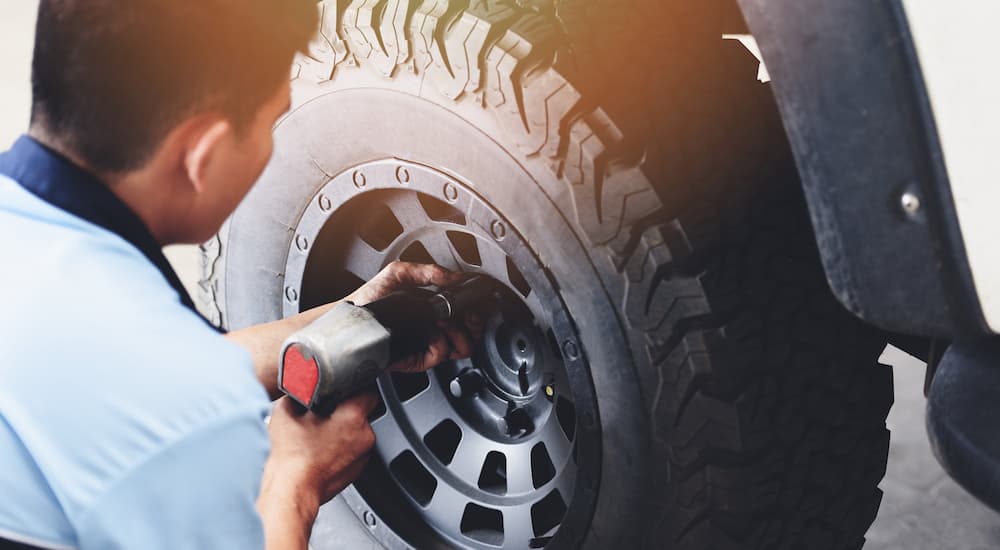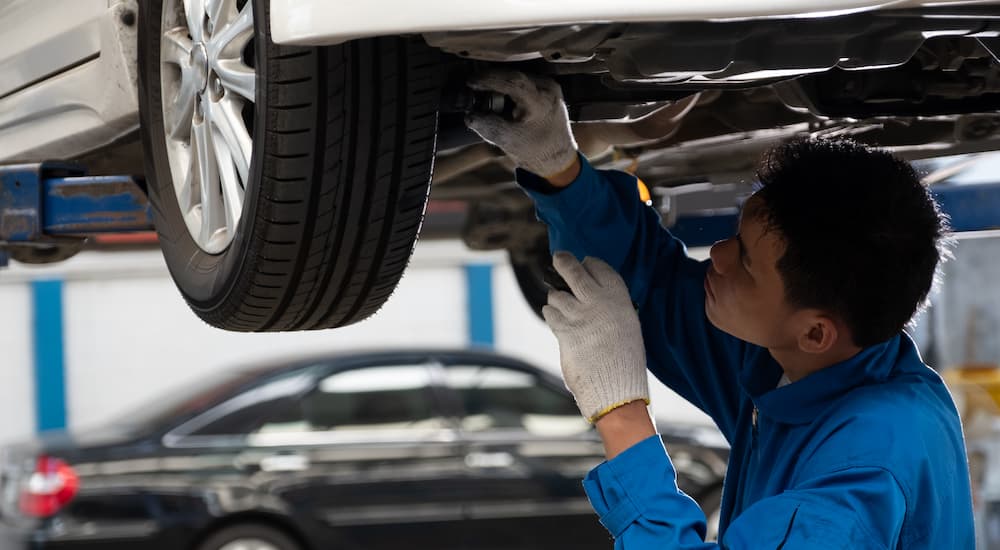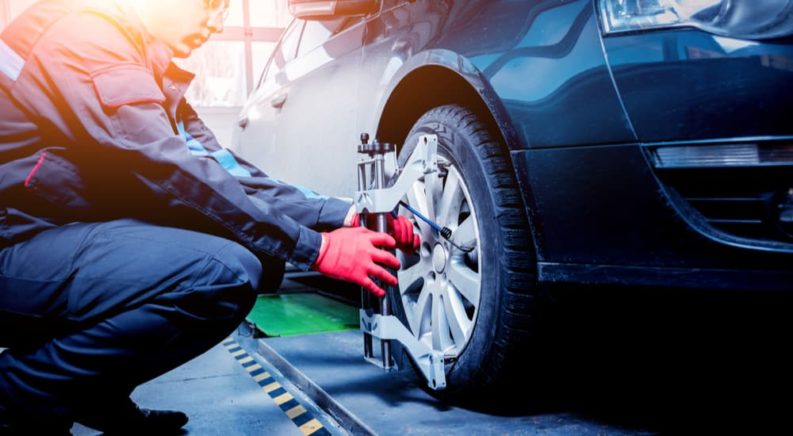Yes, correct wheel alignment on your vehicle is very important in order for your car to operate properly, provide you with optimal fuel efficiency, and make your daily driving as easy and hassle-free as possible. Although proper alignment is important for every vehicle, when you’re looking at Jeep alignment, for example, this can be even more vital. This is particularly important if you like to experience the full potential of your Jeep and take it off-road. All sorts of driving can impact your suspension, but the abuses your Jeep likely goes through on the trail are even harder on it.
I’ll admit that wheel alignment isn’t exactly the sexiest part of owning a vehicle, but it’s very essential to getting the most from your car. Improper alignment can cause more damage to your vehicle, especially the tires, and makes driving far less fun. What’s worse, combining an improper alignment with something unforeseen—like a big pothole or trying to swerve to avoid an animal in the road—can easily lead to a crash. Taking care of your vehicle is the best way to keep it running beautifully for as long as possible, and proper wheel alignment is a major component of its longevity.

What Is Wheel Alignment?
Referred to as “wheel alignment,” “tire alignment,” or simply “alignment,” they all refer to the same thing: how well-configured your vehicle’s suspension is. The alignment is measured by how your wheels and tires are oriented, but the actual adjustment when needed involves your suspension. Checking and adjusting your alignment is something you can do at home, but you need the right equipment for the job. It’s also important that you have experience and know what you’re doing any time you mess with your suspension—this is why so many people prefer to just let the professionals handle it.
Your wheel alignment actually refers to three different things, though they all relate to the orientation of your wheels when viewed from various positions around your car. Camber involves looking at your car head-on; positive camber means the tops of your tires are angled away from your vehicle. Meanwhile, negative camber means they’re angled in toward it. If you were to look down at your vehicle from above, then you could check the toe alignment; toe in means the fronts of your wheels are angled in toward the center of your vehicle, while toe out means they’re angled away. Caster angle indicates how your steering axis aligns when viewed from the side of your car: positive caster means it’s angled toward the back of your vehicle and negative caster means it’s angled toward the front of your car.
You may also hear people talking about tire balancing related to alignment but it’s worth noting that balancing is a separate thing. Tire or wheel balance refers to how they’re positioned to compensate for the weight of your vehicle—this is often done when alignment is adjusted, which is why they’re mentioned together—but they are distinct things. When your wheels are aligned properly, your car will drive smoothly and your experience behind the wheel will offer greater control. Improper alignment makes driving distinctly more challenging, as you effectively have to fight against what your vehicle is doing to maintain control.
Dangers of Improper Alignment
There are several risks involved with driving around in a vehicle with improper alignment, some of which are relatively minor, while others can be a much greater issue. For starters, if your alignment is off, then your vehicle will typically try to veer off to one side or the other unless you constantly correct for it. As a minor issue, this will wear down your tires in an uneven way, which means you’ll need to get new tires put on your vehicle much sooner than you would otherwise. If you have this corrected promptly, then it’s an added expense. If you ignore the problem, though, your tire could be damaged or even blow out; this can be both dangerous and expensive.
Another minor issue is that improper alignment can reduce the efficiency of your vehicle compared to manufacturer and EPA estimates. This means you’ll be stopping for gas more often. Plus, reduced efficiency can make your vehicle far less enjoyable to drive, as if you must constantly be mindful of your driving range.
Your car is designed to be operated with proper alignment; driving around with your suspension off can potentially damage other parts of your vehicle. The alignment itself can also be worn out more quickly as other suspension issues arise, so you might need to replace your shocks or springs on a consistent basis.
Perhaps the biggest danger of driving with a bad alignment is how it changes your driving habits—this can make a bad situation much worse. Driving with a poor alignment means you’re fighting against your vehicle just to go in a straight line, so your steering wheel will typically be off-center while on the highway or driving down the street. If something happens and you suddenly need to swerve, or you strike a pothole or object in the road, then it’s much easier for you to end up in a crash since you’re not driving smoothly to begin with. Recovering from a skid, avoiding an obstacle, and reacting to sudden traffic changes can already be a challenge; trying to do that when your alignment is off and less responsive can result in disaster.

Signs Your Alignment Is Off
There are a few things you should keep an eye out for when you’re driving that can indicate your alignment is off and needs adjusting. One of the most common signs that you need to have your wheels aligned is that your vehicle will drift to the left or right when it should be going straight. This is easy to look for by finding a straightaway without other traffic around you, and then letting the steering wheel slip from your hands; then, see if your car goes relatively straight or tends to drift. Similarly, if you notice that you have your steering wheel at an angle when driving straight, then that can mean that it’s drifting and you’re correcting for it without even realizing it. This is a common sign of improper alignment.
Since the alignment is related to your vehicle’s suspension, sometimes you can physically feel issues through the steering wheel. If you notice excessive vibrations (not simply from a rough road) coming through the steering wheel while you’re driving, then this can indicate you have a problem with your alignment or another issue with your suspension. Assuming you visually inspect your tires regularly, if you notice uneven wear on them, then this can indicate a problem with your suspension, one of which may be poor alignment.
When to Take Care of Alignment
In general, even if you don’t notice any indicators that you have problems with your alignment, it’s a good idea to have it checked once or twice a year. It’s easy to work this task into other maintenance that lifts your vehicle, like rotating your tires, switching from all-season to winter tires, or getting an oil change. Of course, if you do notice any indicators that your suspension is flawed, have it checked and fixed right away at your local automotive service center before a small problem becomes a major issue.
You can also check your vehicle’s owner’s manual to see how often the manufacturer suggests you have the alignment checked or adjusted. About every 6,000 miles is a good general rule for most vehicles. Overall, having your alignment inspected and adjusted regularly is a simple way to keep your vehicle in great shape and empowers you to enjoy every drive to the fullest.

